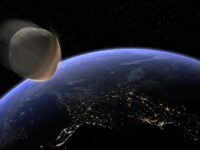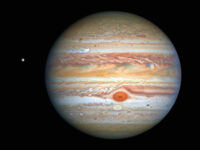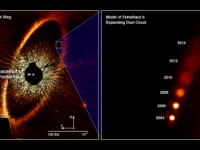The trees dance in the morning light, their branches waving in the breeze. The meadows stretch vast, decorated with swaths of verdant reds, blues, and purples. A ribbon of water cuts through the valley, bending towards the horizon. Such images often come to mind when considering the singular beauty of Earth, especially in comparison to the desolate terrains of other popularly known planets, such as the barren surface of Mars. However, there is the distinct possibility that Earth may not be the only planet able to harbor life. Earth might not be the singular diamond that it was once thought to be.
According to a study recently published in Astrobiology by Dirk Schulze-Makuch, a professor at Washington State University and the Technical University of Berlin, “habitability” is a planet’s potential to harbor life. Of course, this proves difficult to determine when trying to identify other planets that could contain life.
A planet may very well have the ability to harbor life but remains lifeless all the same because the origin of life never happened to blossom. This could take place because the origin of life has much stricter conditions of occurrence than the continued persistence of life.
Therefore, a planet can have the conditions for life, but not contain it. Another immediate obstacle to identifying habitable planets is a lack of knowledge. The only planet known to have any sort of organism is Earth, and thus humanity only knows of the conditions for life which are present on this planet. In reality, life could exist in wildly different possibilities under seemingly impossible circumstances.
Life could thrive in many more environments than it does on Earth, given that there could be a nearly infinite range of alternative biochemistries. There could be many more types of life on a single planet as well, which could perform a wider range of functions.
The general definition of what constitutes a habitable planet comes from the only truly reliable data model humanity possesses, which is Earth. An environment even more habitable than Earth would be classified as superhabitable. When examining this phenomenon, scientists formally observe planets through the lens of two measures: biomass and biodiversity. However, finding no evidence of these two factors may not necessarily be indicative of a lack of superhabitability. Evolution, resulting in the rise of intelligent species and complex ecosystems on Earth, was due as much to chance as it was to Earth’s favorable conditions. Consequently, when trying to identify similar pathways on other planets, experts must take the factor of luck into account.
Since everything in space is so far away anyway, much of the search centers around broader physical factors. One such factor that experts observe through telescopes is the presence of atmosphere. Without an atmosphere, water on the surface is not stable in liquid form and is lost into space. For instance, take the Earth and the moon. They both reside in the solar habitable zone, yet the absence of a lunar atmosphere has resulted in the barren, lifeless surface of the moon.
Life could thrive in many more environments than it does on Earth, given that there could be a nearly infinite range of alternative biochemistries. There could be many more types of life on a single planet as well, which perform a wider range of functions.
Another property observable to long-range telescopes is the star around which the system revolves. Dwarf stars of spectral type G (known as dG stars), such as the sun, may not be the most favorable for life.
Young dG (dwarf type G) stars happen to rotate about 10 times faster than dG stars that are about the age of the sun, and thus have higher levels of magnetic dynamo-driven activity as well as intense coronal X-ray and chromospheric FUV (far ultraviolet) emissions. These two factors make the emergence of life incredibly difficult, as most life cannot survive such conditions. These properties lift K-dwarf stars into the realm of superhabitability because they lack these problems.
In reality, life could exist in wildly different possibilities under seemingly impossible circumstances.
Turning to planetary factors, there are a few which are notable. According to Schulze-Makuch, an ideal planet would be up to 1.5 times more massive than Earth. A larger planet is indicative of a larger surface area, which allows for more space for life to thrive. It is then obvious that such a planet can support more biomass and biodiversity.
Another advantage of having a larger planetary mass includes greater magnitudes of interior heating through radioactive decay, which allows the planet to stay habitable for a longer time. Furthermore, a planet with a larger mass has greater gravity, and thus retains a thicker atmosphere. Interestingly, this might encourage flight as a more prominent form of locomotion.
An average global temperature of five degrees Celsius above Earth’s temperature is also favorable. The most abundant period in Earth’s history, meaning the era in which the most biomass was produced, was the Carboniferous Period, which provided much of the fuel that powers modern society in the form of coal, oil, and natural gas. During this period, the average global temperature of the planet was around five degrees higher than it is today.
Upon considering a few other factors, experts can finally determine superhabitability. So far, they have found around 24 candidates. Of the 24 candidates, nine of them happen to orbit K stars, 16 are between 5 and 8 billion years old, and five of them are within the 10-degree range of the temperature optimal for superhabitability.
One of these planets stands above the rest, labeled as KOI 5715.01. It happens to meet all three criteria of the determination of superhabitability: ideal temperature, age, and orbit around an optimal star. The temperature is slightly lower than ideal, but if the planet has a thicker atmosphere, and thus a stronger greenhouse effect, then the planet could hold conditions more suitable for life than our own planet. Perhaps KOI 5715.01, or a planet like it, holds the answer to one of humanity’s greatest questions: Is there life beyond the bounds of Earth?
Astrobiology (2020). DOI: 10.1089/ast.2019.2161






